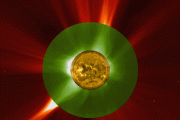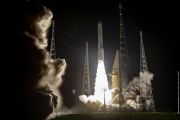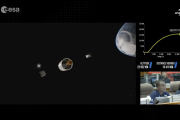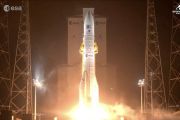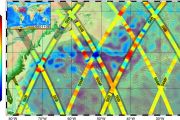
Copernical Team
Waking up Juice
 Video:
00:01:00
Video:
00:01:00
It takes a while for a new mission to wake up after the rigours of launch, but before it’s fully in flight configuration it’s still exposed to the harsh realities of space. During this critical period, known as the ‘Launch and Early Orbit Phase’ or ‘LEOP’, teams at ESA’s mission control in Darmstadt, Germany, have to work fast to establish contact with the fledgling mission, and ensure its solar arrays are correctly powering the mission.
Once ESA’s Jupiter Icy Moons Explorer, Juice, separates from its Ariane 5 rocket, there will be two key moments to look out for.
Taiwan seeks satellite solutions after undersea cables cut
 Taiwanese hostel worker Wang Chuang-jen's business took a hammering when undersea telecoms lines serving tiny Matsu archipelago were cut in February.
"It was very inconvenient," said the 35-year-old from Matsu's Beigan island, where customers struggled to book or pay online due to slow connectivity. "We all heavily depend on the internet."
The cut-off not only caused headaches for busine
Taiwanese hostel worker Wang Chuang-jen's business took a hammering when undersea telecoms lines serving tiny Matsu archipelago were cut in February.
"It was very inconvenient," said the 35-year-old from Matsu's Beigan island, where customers struggled to book or pay online due to slow connectivity. "We all heavily depend on the internet."
The cut-off not only caused headaches for busine Slip and Pivot: Sol 3797
 As you can see in the above image, the terrain our rover drivers is navigating is challenging - slippery sand surrounding big, wheel-unfriendly rocks. These contrasting regimes contributed to us not-quite-arriving at our planned workspace with all six wheels confidently on known terrain.
Thus, we had to pivot from a combined contact and remote science day, to one with remote science and a
As you can see in the above image, the terrain our rover drivers is navigating is challenging - slippery sand surrounding big, wheel-unfriendly rocks. These contrasting regimes contributed to us not-quite-arriving at our planned workspace with all six wheels confidently on known terrain.
Thus, we had to pivot from a combined contact and remote science day, to one with remote science and a China bans ships from area north of Taiwan Sunday due to 'falling rocket wreckage'
 China will ban ships from entering an area north of Taiwan on Sunday due to "possible falling rocket wreckage", a provincial maritime authority said.
The area around 100 miles (160 kilometres) from Taipei will be closed from 9 am (0100 GMT) to 3 pm (0700 GMT), the maritime safety administration of China's eastern Fujian province said Thursday, adding that ships will be "forbidden to enter".
China will ban ships from entering an area north of Taiwan on Sunday due to "possible falling rocket wreckage", a provincial maritime authority said.
The area around 100 miles (160 kilometres) from Taipei will be closed from 9 am (0100 GMT) to 3 pm (0700 GMT), the maritime safety administration of China's eastern Fujian province said Thursday, adding that ships will be "forbidden to enter". Ariane 5 VA 260 with Juice - Integration and rollout timelapse
 Video:
00:01:58
Video:
00:01:58
Ariane 5 VA 260 with Juice integration and rollout timelapse at Europe's Spaceport in French Guiana.
Juice – Jupiter Icy moons Explorer – is humankind’s next bold mission to the outer Solar System. This ambitious mission will characterise Ganymede, Callisto and Europa with a powerful suite of remote sensing, geophysical and in situ instruments to discover more about these compelling destinations as potential habitats for past or present life. Juice will monitor Jupiter’s complex magnetic, radiation and plasma environment in depth and its interplay with the moons, studying the Jupiter system as an archetype for gas giant systems across the Universe.
Following launch, Juice will
Chinese FY-3 satellites enrich global soil moisture dataset
 Surface soil moisture (SSM) plays an important role in drought and flood monitoring, weather forecasting, among other natural resource activities, and is also critical in water and heat exchanges between land and atmosphere.
SSM can be measured by instruments in the field or by remote sensing techniques. Satellite observations from active and passive microwave sensors are best suited for t
Surface soil moisture (SSM) plays an important role in drought and flood monitoring, weather forecasting, among other natural resource activities, and is also critical in water and heat exchanges between land and atmosphere.
SSM can be measured by instruments in the field or by remote sensing techniques. Satellite observations from active and passive microwave sensors are best suited for t Rocket Lab to launch NASA's cyclone-tracking satellite constellation from New Zealand
 Rocket Lab USA, Inc. (Nasdaq: RKLB) will launch NASA's TROPICS constellation across two dedicated Electron missions lifting off from Launch Complex 1 in New Zealand next month.
The TROPICS constellation (Time-Resolved Observations of Precipitation Structure and Storm Intensity with a Constellation of Small Sats) will monitor the formation and evolution of tropical cyclones, including hurri
Rocket Lab USA, Inc. (Nasdaq: RKLB) will launch NASA's TROPICS constellation across two dedicated Electron missions lifting off from Launch Complex 1 in New Zealand next month.
The TROPICS constellation (Time-Resolved Observations of Precipitation Structure and Storm Intensity with a Constellation of Small Sats) will monitor the formation and evolution of tropical cyclones, including hurri Civil engineers use public satellite images to study why the Jagersfontein dam failed
 On 11 September 2022, a diamond mine waste storage facility, known as a tailings dam, failed in the town of Jagersfontein in the Free State province of South Africa. In the failure, one person was killed and multiple homes destroyed.
Tailings are the finely ground leftovers that remain after valuable metals are removed from rock ore. Tailings are generally transported jointly with water an
On 11 September 2022, a diamond mine waste storage facility, known as a tailings dam, failed in the town of Jagersfontein in the Free State province of South Africa. In the failure, one person was killed and multiple homes destroyed.
Tailings are the finely ground leftovers that remain after valuable metals are removed from rock ore. Tailings are generally transported jointly with water an Battle for space power plays out in technology, science - politics and policy
 The expanding use of outer space for human activities requires increasing attention to policies and governance, with a Flinders University space expert warning of an increasing need for a well-developed strategic plan to manage competing national interests.
In a new publication, Associate Professor Rodrigo Praino says the race to explore and possibly settle the Moon, Mars and control satel
The expanding use of outer space for human activities requires increasing attention to policies and governance, with a Flinders University space expert warning of an increasing need for a well-developed strategic plan to manage competing national interests.
In a new publication, Associate Professor Rodrigo Praino says the race to explore and possibly settle the Moon, Mars and control satel Sidus Space and L3Harris yeam for the DoD Mentor-Protege Program
 Sidus Space, Inc. (NASDAQ:SIDU), a Space-as-a-Service company focused on commercial satellite design, manufacture, launch, and data collection, is teaming with L3Harris Technologies (NYSE:LHX) for the Department of Defense Mentor-Protege Program (MPP).
DoD program helps businesses expand their footprint in the defense industrial base by supporting their partnering efforts with larger compa
Sidus Space, Inc. (NASDAQ:SIDU), a Space-as-a-Service company focused on commercial satellite design, manufacture, launch, and data collection, is teaming with L3Harris Technologies (NYSE:LHX) for the Department of Defense Mentor-Protege Program (MPP).
DoD program helps businesses expand their footprint in the defense industrial base by supporting their partnering efforts with larger compa 














